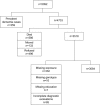Occupational exposure to pesticides increases the risk of incident AD: the Cache County study
- PMID: 20458069
- PMCID: PMC2875926
- DOI: 10.1212/WNL.0b013e3181dd4423
Occupational exposure to pesticides increases the risk of incident AD: the Cache County study
Abstract
Background: Commonly used organophosphate and organochlorine pesticides inhibit acetylcholinesterase at synapses in the somatic, autonomic, and central nervous systems and may therefore have lasting effects on the nervous system. Few studies have examined the relationship of pesticide exposure and risk of dementia or Alzheimer disease (AD). We sought to examine the association of occupational pesticide exposure and the risk of incident dementia and AD in later life.
Methods: Residents of the agricultural community of Cache County, UT, who were aged 65 years and older as of January 1995, were invited to participate in the study. At baseline, participants completed detailed occupational history questionnaires that included information about exposures to various types of pesticides. Cognitive status was assessed at baseline and after 3, 7, and 10 years. Standardized methods were used for detection and diagnosis of dementia and AD. Cox proportional hazards survival analyses were used to evaluate the risk of incident dementia and AD associated with pesticide exposure.
Results: Among 3,084 enrollees without dementia, more men than women reported pesticide exposure (p < 0.0001). Exposed individuals (n = 572) had more years of education (p < 0.01) but did not differ from others in age. Some 500 individuals developed incident dementia, 344 with AD. After adjustment for baseline age, sex, education, APOE epsilon4 status, and baseline Modified Mini-Mental State Examination scores, Cox proportional hazards models showed increased risks among pesticide-exposed individuals for all-cause dementia, with hazard ratio (HR) 1.38 and 95% confidence interval (CI) 1.09-1.76, and for AD (HR 1.42, 95% CI 1.06-1.91). The risk of AD associated with organophosphate exposure (HR 1.53, 95% CI 1.05-2.23) was slightly higher than the risk associated with organochlorines (HR 1.49, 95% CI 0.99-2.24), which was nearly significant.
Conclusions: Pesticide exposure may increase the risk of dementia and Alzheimer disease in late life.
Comment in
-
Alzheimer disease: Risk of dementia and Alzheimer disease increases with occupational pesticide exposure.Nat Rev Neurol. 2010 Jul;6(7):353. doi: 10.1038/nrneurol.2010.80. Nat Rev Neurol. 2010. PMID: 20653096 No abstract available.
References
-
- Carlock LL, Chen WL, Gordon EB, et al. Regulating and assessing risks of cholinesterase-inhibiting pesticides: divergent approaches and interpretations. J Toxicol Environ Health B Crit Rev 1999;2:105–160. - PubMed
-
- Baldi I, Lebailly P, Mohammed-Brahim B, Letenneur L, Dartigues JF, Brochard P. Neurodegenerative diseases and exposure to pesticides in the elderly. Am J Epidemiol 2003;157:409–414. - PubMed
-
- van Wendel de Joode B, Wesseling C, Kromhout H, Monge P, Garcia M, Mergler D. Chronic nervous-system effects of long-term occupational exposure to DDT. Lancet 2001;357:1014–1016. - PubMed
-
- Osteen C. Pesticide use trends and issues in the United States. In: Pimentel D, Lehman H, eds. The Pesticide Question: Environment, Economics, and Ethics. New York: Chapman & Hall; 1993: 307–336.
Publication types
MeSH terms
Substances
Grants and funding
LinkOut - more resources
Full Text Sources
Medical
Miscellaneous

